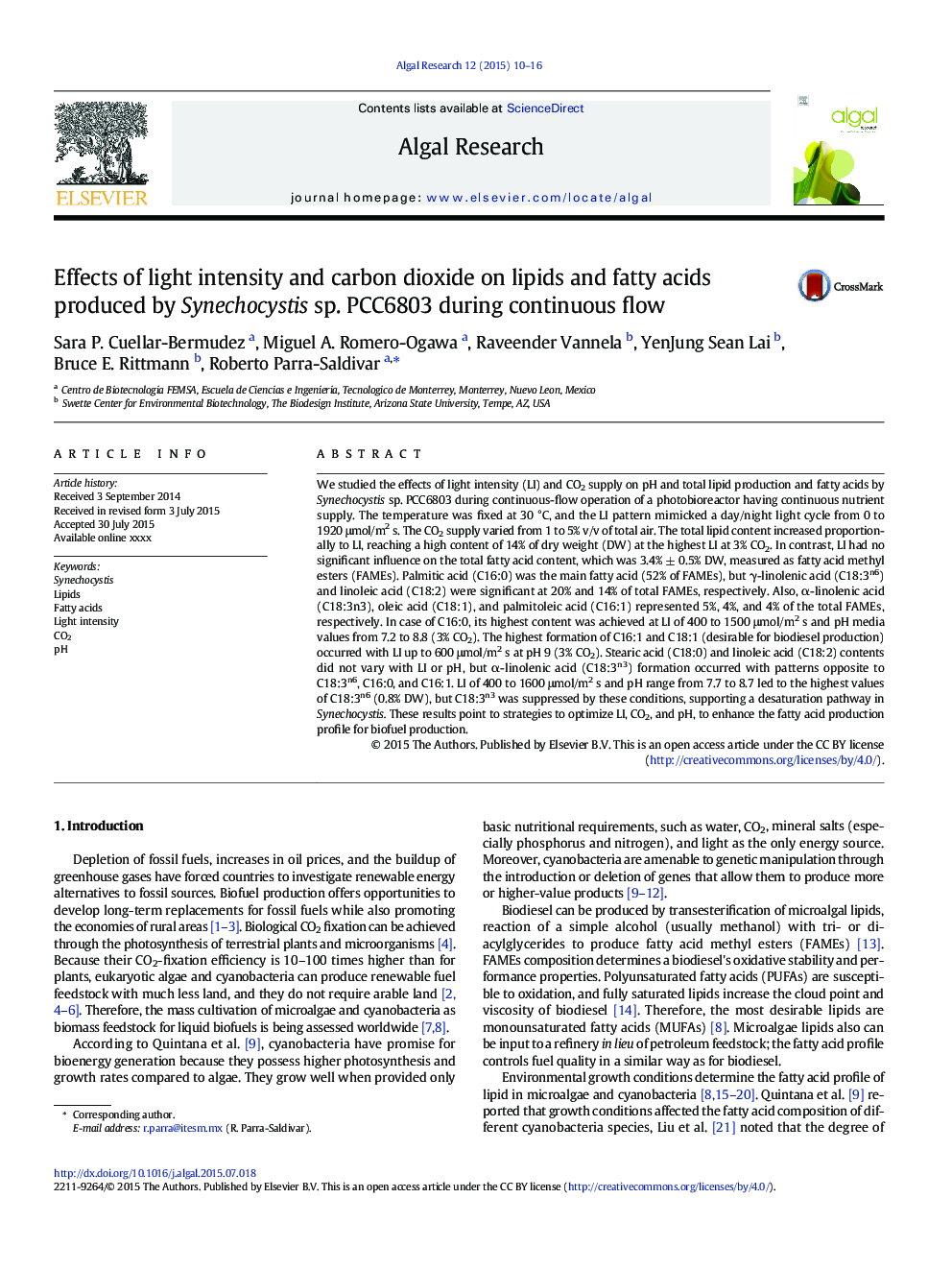| کد مقاله | کد نشریه | سال انتشار | مقاله انگلیسی | نسخه تمام متن |
|---|---|---|---|---|
| 8087709 | 1521820 | 2015 | 7 صفحه PDF | دانلود رایگان |
عنوان انگلیسی مقاله ISI
Effects of light intensity and carbon dioxide on lipids and fatty acids produced by Synechocystis sp. PCC6803 during continuous flow
دانلود مقاله + سفارش ترجمه
دانلود مقاله ISI انگلیسی
رایگان برای ایرانیان
کلمات کلیدی
موضوعات مرتبط
مهندسی و علوم پایه
مهندسی انرژی
انرژی های تجدید پذیر، توسعه پایدار و محیط زیست
پیش نمایش صفحه اول مقاله

چکیده انگلیسی
We studied the effects of light intensity (LI) and CO2 supply on pH and total lipid production and fatty acids by Synechocystis sp. PCC6803 during continuous-flow operation of a photobioreactor having continuous nutrient supply. The temperature was fixed at 30 °C, and the LI pattern mimicked a day/night light cycle from 0 to 1920 μmol/m2 s. The CO2 supply varied from 1 to 5% v/v of total air. The total lipid content increased proportionally to LI, reaching a high content of 14% of dry weight (DW) at the highest LI at 3% CO2. In contrast, LI had no significant influence on the total fatty acid content, which was 3.4% ± 0.5% DW, measured as fatty acid methyl esters (FAMEs). Palmitic acid (C16:0) was the main fatty acid (52% of FAMEs), but γ-linolenic acid (C18:3n6) and linoleic acid (C18:2) were significant at 20% and 14% of total FAMEs, respectively. Also, α-linolenic acid (C18:3n3), oleic acid (C18:1), and palmitoleic acid (C16:1) represented 5%, 4%, and 4% of the total FAMEs, respectively. In case of C16:0, its highest content was achieved at LI of 400 to 1500 μmol/m2 s and pH media values from 7.2 to 8.8 (3% CO2). The highest formation of C16:1 and C18:1 (desirable for biodiesel production) occurred with LI up to 600 μmol/m2 s at pH 9 (3% CO2). Stearic acid (C18:0) and linoleic acid (C18:2) contents did not vary with LI or pH, but α-linolenic acid (C18:3n3) formation occurred with patterns opposite to C18:3n6, C16:0, and C16:1. LI of 400 to 1600 μmol/m2 s and pH range from 7.7 to 8.7 led to the highest values of C18:3n6 (0.8% DW), but C18:3n3 was suppressed by these conditions, supporting a desaturation pathway in Synechocystis. These results point to strategies to optimize LI, CO2, and pH, to enhance the fatty acid production profile for biofuel production.
ناشر
Database: Elsevier - ScienceDirect (ساینس دایرکت)
Journal: Algal Research - Volume 12, November 2015, Pages 10-16
Journal: Algal Research - Volume 12, November 2015, Pages 10-16
نویسندگان
Sara P. Cuellar-Bermudez, Miguel A. Romero-Ogawa, Raveender Vannela, YenJung Sean Lai, Bruce E. Rittmann, Roberto Parra-Saldivar,